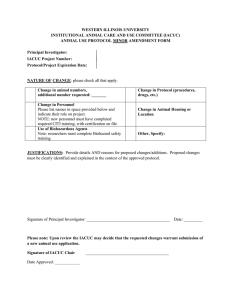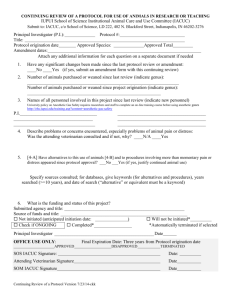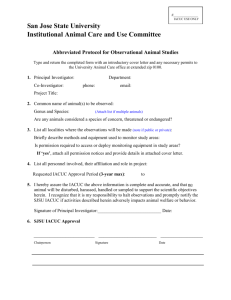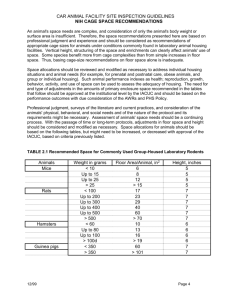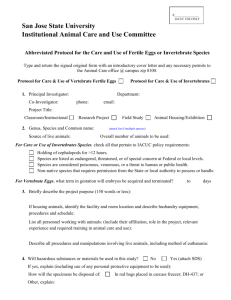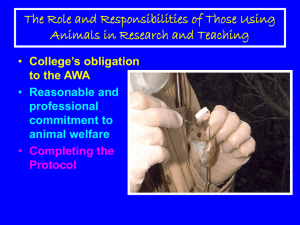Laboratory Animal Care Facility Standard Operating Procedures
advertisement
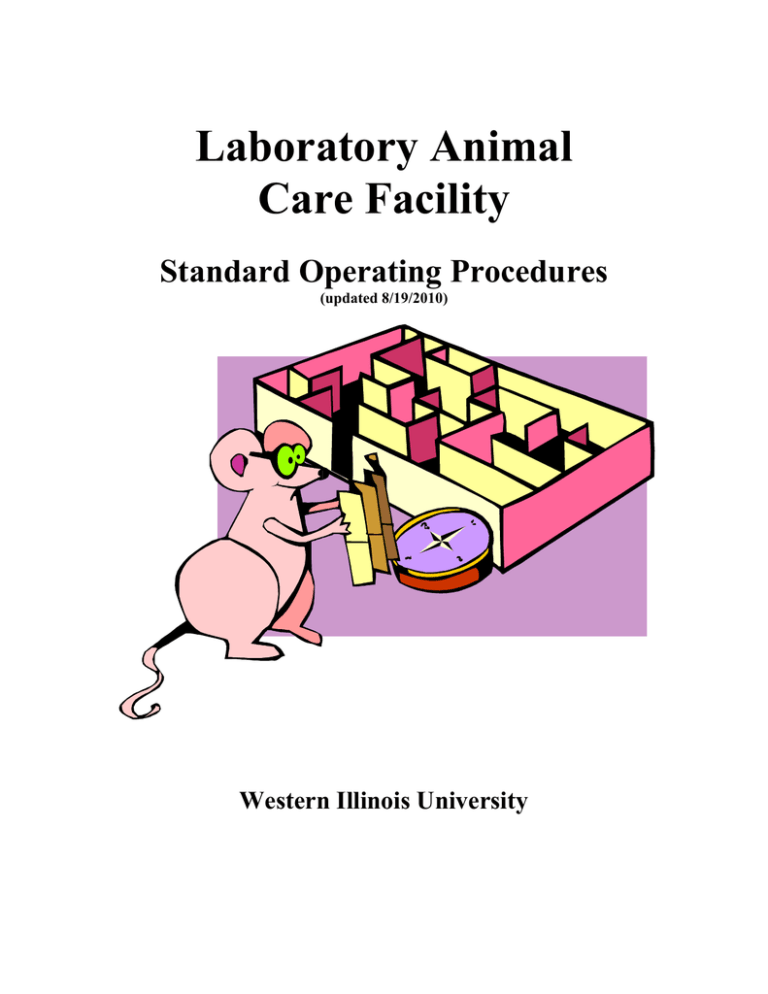
Laboratory Animal Care Facility Standard Operating Procedures (updated 8/19/2010) Western Illinois University Table of Contents MISSION ........................................................................................................................ - 3 GOALS ........................................................................................................................... - 3 GUIDELINES ................................................................................................................. - 3 I. Daily Operating Schedule ....................................................................................... - 5 A. Initial Inspection ............................................................................................... - 5 1. Security of the facilities ................................................................................ - 5 - 2. Physical Plant ............................................................................................... - 5 - B. Animal Health .................................................................................................. - 6 - C. Water ................................................................................................................ - 6 - D. Feed .................................................................................................................. - 6 - E. Cleaning ........................................................................................................... - 6 - F. Daily Room Worksheet Log ................................................................................ - 7 II. Care of Specific Species ......................................................................................... - 7 A. Rats – Rattus norvegicus .................................................................................. - 7 - B. Mice – Mus musculus ...................................................................................... - 7 - C. Chickens – Gallus gallus .................................................................................. - 7 1. Day old chicks to three weeks old. ............................................................... - 7 - 2. Chickens three weeks old and older ............................................................. - 8 - D. Rabbits – Oryetolagus cuniculus ...................................................................... - 8 - E. Amphibians and Reptiles ................................................................................. - 8 - F. Hamsters – Mesocricetus auratus ...................................................................... - 8 - G. Wild Trapped.................................................................................................... - 9 - H. III. 1. Voles – Microtus ochrogaster ...................................................................... - 9 - 2. Deer Mice ..................................................................................................... - 9 New Species ..................................................................................................... - 9 Facility Management ........................................................................................... - 9 - A. General Overview ............................................................................................ - 9 - B. Quarantine ...................................................................................................... - 10 - C. Animals .......................................................................................................... - 10 - D. Storage areas .................................................................................................. - 10 - E. Cage washer ................................................................................................... - 10 - F. Feed ................................................................................................................. - 10 - -1- G. Bedding .......................................................................................................... - 11 - H. Surgery ........................................................................................................... - 11 - I. Experimental Areas ............................................................................................ - 11 - IV. Purchasing Guidelines ....................................................................................... - 11 - A. Fiscal agents’ responsibilities ........................................................................ - 11 - B. Animals .......................................................................................................... - 12 - C. Supplies .......................................................................................................... - 12 - D. V. 1. Feed ............................................................................................................ - 12 - 2. Bedding ....................................................................................................... - 12 - 3. Cleaning Supplies ....................................................................................... - 12 - 4. Laboratory Supplies .................................................................................... - 12 Equipment ...................................................................................................... - 13 - Training ................................................................................................................. - 13 A. Requirements for all lab personnel................................................................. - 13 - B. Continuing education ..................................................................................... - 13 - VI. Emergency procedures ...................................................................................... - 13 - APPENDIX A ............................................................................................................... - 14 APPENDIX B ............................................................................................................... - 19 APPENDIX C ................................................................................................................. - 20 -2- MISSION The mission of the Department of Laboratory Animal Care is to provide the highest level of animal care possible with the resources available. The Department strives to provide healthy animals in support of education and research at the University. GOALS There is a series of guidelines and oversight committees in place to assure the appropriate care of the laboratory animals under the charge of the Laboratory Animal Care Department. All are in place to insure that the facility’s operation meets or exceeds all applicable regulations and guidelines. Because the care of an animal is a dynamic activity, one must cultivate the well-being of the animal and must anticipate and solve problems before they occur. GUIDELINES The guidelines followed by the Laboratory Animal Care Department are outlined in the following publications: IACUC’s Guidelines, Standard Operating Procedures, Western Illinois University Guide for Care and Use of Laboratory Animals, by Institute of Laboratory Animal Resources, National Research Council Report of AVMA Panel on Euthanasia, 2000 Operating guidelines as set forth by the APHIS/USDA and the NIH/Office for Protection from Research Risks (OPRR) Guidelines for Use of Fishes in Field Research (American Society of Ichthyologists and Herpetologists, American Fisheries Society, and American Institute of Fisheries Research Biologists) Acceptable Field Methods in Mammalogy (American Society of Mammalogists) Use of Wild Birds in Research (American Ornithologists’ Union) Guidelines for Use of Live Amphibians and Reptiles in Field Research (American Society of Ichthyologists and Herpetologists, The Herpetologists League, and the Study of Amphibians and Reptiles) -3- -4- I. Daily Operating Schedule A. Initial Inspection Daily, upon opening of the lab, the first priority is to inspect the total facility. Check for anything unusual. Look for water spills, empty water bottles, feed spillage, etc. Check the general condition of all animals and their environment. Decide what plan of action is necessary to start the day. 1. Security of the facilities Has anything changed or seem out of place from the previous day? The lab is not a high traffic area; look especially to the doors, locks, lighting, light timers, missing or moved equipment and animals. Note any doors that were left unlocked. 2. Physical Plant a) Lighting Check light fixtures for outages. Maintenance personnel are not always aware of the lighting regiments in the lab. The light timers on animal rooms need to be checked and time corrected if "off." b) Humidity Most laboratory animals prefer a relative humidity (RH) around 50%, but can tolerate a range of 40-70% as long as it remains relatively constant and the temperature range is appropriate (Clough, 1987). Check thermohydrographs for humidity level. Call the Physical Plant if out of normal parameters. The normal range is between 35 and 50% RH. c) Air Quality Check that the ventilation system is "on." "The smell of the room" is a good indication of system operation. If an “off” odor is present, locate the cause and take corrective action as needed. Check air filtration units for proper function. -5- d) Temperature Check thermostats and thermohydrographs in each room. The air temperature is not normally critical for most mature animals (with the exception of chinchillas); they are quite tolerant of temperature swings within limits. However, temperatures below 65 or over 75 may indicate a problem that must be corrected. Pay special attention to young, aged, and nursing animals as rapid temperature swings can be unhealthy. B. Animal Health Check each cage in each rack for signs of the animals being "off," i.e., respiratory sounds, discharge from eyes, damp posterior, activity level and overall appearance. Notice the consumption of feed and water. Check the appearance of the fecal matter. If any appear abnormal, assess the problem and take necessary corrective action. Notify Veterinary Services, the researcher involved and note in the log book any abnormal conditions found and corrective actions taken. C. Water All animals DRINK DAILY. If the water supply in a bottle is not lower from the previous day, find the cause. Possible reasons are: 1) stuck sipper tube balls; 2) sipper tube not located within the cage; 3) tube plugged with bedding and/or feed; 4) contaminated water -- check for odor, clarity and turbulence; 5) the animal may be ill. Refill water bottles when they are one-half empty as a general rule. Exceptions are baby chickens in brooders and lactating rats -- they must be refilled daily. When refilling water bottles, fill all bottles on a rack at one time, do not refill a few! When filling water bottles, empty water and rinse before refilling. Water bottles are changed out every two weeks. D. Feed The feed level should be down daily; if not, find the reason. Possible causes are: 1) feed bridged in the feeder; 2) sour or moldy feed; 3) the animals may have "soiled" the feed in the feeder with fecal material and/or urine; or 4) the animal may be ill! All animals in the lab are on Ad Lib feeding unless cages and racks are marked to the contrary. Feeders should be refilled when one-half to threefourths empty, with the exception of lactating rats which must be refilled daily. Animals housed with contact bedding and suspended cage tops should be given enough feed for about three days (about 8 to 12 ounces). E. Cleaning Floors in animal rooms shall be swept, vacuumed or mopped daily. Any spillage shall be cleaned up at the time of the spill, not left to later. -6- F. Daily Room Worksheet Log Daily Room Worksheet Log will be completed by each technician and kept on file in the Lab Office for inspection. II. Care of Specific Species A. Rats – Rattus norvegicus Rats may be housed in several types of caging. Most rats are housed in suspended stainless steel wire bottom cages or in "tubs" with contact bedding (preferred). Feed for colony rats and research animals, unless on special diets, is Purina Rat Chow 5012 or equivalent. Water is supplied in glass water bottles with double ball sipper tubes. Water shall be changed no less than every three days, normally on Monday, Wednesday, and Friday. Bottles are to be changed out with clean bottles on a bi-weekly basis. Litter trays and tub cages are changed weekly. B. Mice – Mus musculus Mice are normally housed in polyethylene tub cages with wire lids and contact bedding. Tubs are changed with a clean tub and bedding weekly, or more frequently if needed. Clean tubs with wood chip bedding and nesting material is used for housing a late gestating or lactating female mouse. The feed for all mice is Purina Mouse Chow 5015 or equivalent. Water shall be changed no less than every three days, normally on Monday, Wednesday, and Friday. Bottles are to be changed out with clean bottles on a bi-weekly basis. C. Chickens – Gallus gallus Chickens are housed in two types of caging depending on their age. 1. Day old chicks to three weeks old. Upon arrival, chicks are to be individually inspected, beaks clipped and beaks dipped into the watering fountain. They are then housed in electrically heated brooders. Kraft paper shall cover wire flooring for the first three days. Paper should be changed daily! A water trough shall be supplemented with a water fountain in the middle of brooder. Water in the trough and fountain needs to be changed daily. Scratch feed should be distributed on paper for the first three days. Check the temperature of the roosting area frequently. The temperature should be between 85 and 90 degrees. Following the three day starting period, remove paper cover from wire floor and remove water fountain from brooder. Change paper under floor every day for the duration of the starting period. Water trough shall be washed daily and refilled with clean water. Feeder should be refilled daily, paying special attention to the cleanliness of the feeder. If the feeder becomes fouled, -7- dump and replace with a clean feeder and feed. No additives are necessary in the drinking water. Feed is to be Purina Chick Starter or equivalent. 2. Chickens three weeks old and older Caging is free standing poultry cages in room WG35. Paper under the suspended floor is to be changed daily. Feed is ad lib chicken diet, Purina laying mash or equivalent. Water is via pipeline, automatic-fill watering trough. The unit must be inspected to ascertain proper operation daily. Trough is cleaned and sanitized with a 1% Nolvasan solution or equivalent compound twice weekly. Each cage unit should house no more than three adult chickens. It is necessary for the caretaking staff to closely monitor the chickens to control birds’ pecking at each other. D. Rabbits – Oryetolagus cuniculus The rabbits are housed in stainless steel suspended cages with waste trays. Trays are to be changed three times a week, normally on Monday, Wednesday, and Friday. Water is provided in large glass water bottles with SS ball sipper tubes. Water is to be changed, at the minimum, every three days. Always note the position of the sipper tube when mounting a water bottle to the cage. Feed is to be provided with a bulk type self feeder, not trays or pans. The feeder is to be refilled every two days. Attention should be given to the condition of the feed in the feeder trough. Remove accumulation of feces and/or soiled feed as necessary, and wash feeder. Cage units are to be changed every two weeks. Rabbits are to be handled weekly and inspected for external parasites and overall condition. Check and clean environmental enrichment objects (i.e. golf balls) weekly. E. Amphibians and Reptiles Frogs and turtles, which are to be used for the Biology Department classes, must be used within five days of their arrival in the Lab unless other arrangements have been made prior to their arrival. Housing is provided in galvanized round end cattle tanks. The tank must have one end elevated so as to provide a dry resting area. Water is to be added to the tank to cover about one-half of the bottom and have a maximum depth of approximately four inches. Water is to be changed at least every two days. If the amphibians are to be housed for a greater length of time, food must be provided and additional cleaning of the vessel is necessary. F. Hamsters – Mesocricetus auratus Hamsters are housed in polyethylene tubs with SS wire tops. Bedding is provided in the form of wood chips. Bedding is to be changed at least once weekly and -8- replaced with a clean tub, top and supply of wood chips. Water is provided in pint glass bottles with SS sipper tubes. Water is to be changed every three days. Pay special attention to the space under the water bottles sipper tube; hamsters often exhibit burrowing behavior and build mounds of wood chips plugging the sipper tube. Purina Rat Chow 5012 or equivalent is to be the primary diet of choice. G. Wild Trapped 1. Voles – Microtus ochrogaster Voles are housed in polyethylene mouse tubs, using the same cleaning and maintenance schedule as for mice. Lighting levels should be less than 75 ft candle at the cage top or about one-half of the cage top should be covered if lactating females are being housed in order to reduce cannibalism of the litter. The cages should be located in a remote portion of the animal care facilities in order to reduce noise levels as much as possible. 2. Deer Mice Standard husbandry practices similar to mouse housing is adequate for a deer mouse colony. Due to the high excitability of non-domesticated mice, special precautions should be followed to prevent high noise levels in the area. Caging must be inspected often and kept in good condition. If any sharp corners are present, the mice will chew through the cage. H. New Species Operating procedures regarding the care of a species "new" to the facility must be considered before new species are approved for use. III. Facility Management A. General Overview The primary objective in the operation of the Animal Lab is to provide a CLEAN, healthy environment for the animals housed in the facility. Rooms must be swept, vacuumed, mopped or hosed down daily. Rooms should be emptied of animals and washed down at least every month. Floors should be washed down whenever an accumulation of soil is present (this can vary from every few days to monthly). Any feces, urine or blood on any surface of the room must be removed when found. The use of chemical cleaners can assist in the cleaning of the animals’ environment, BUT the best cleaner in the world is a little elbow grease. -9- B. Quarantine All animals brought into the animal laboratory are to be quarantined for 14 days. The quarantined animals are to be located in a separate room away from all other animals in the lab. The new arrivals shall be inspected by the attending veterinarian to ascertain their health. They shall be cared for after all other procedures with the other lab animals have been completed. The cleaning of their housing and the room in which they reside is to be done in a manner so as to minimize any exposure of the non-quarantined animals in the lab facility. The reason for these techniques is to acclimate the new animals to our facility and to assess their health. C. Animals Different species of animals should not be housed in the same room if at all possible. Segregation of animals helps to reduce disease problems. Research animals should be housed separately from colony and other researchers' animals to allow the researcher access to his animals and maintain security of the lab. This also decreases random variables (i.e., noise) in the data secured for the research. D. Storage areas All areas of the lab, including the storage areas, must be kept clean and orderly to minimize insect vectors. An orderly lab is more accessible to researchers and reduces the danger of accidents. The storage areas are broken down into three major areas: 1) Feed – Room WG30; 2) Glassware and chemical – Room WG28; 3) Caging – Rooms WG06, WG40, and WG42. E. Cage washer The cage washer area, located in room WG42 and WG43, is to be used as the prep and disposal area. Cages and tubs are "dumped" and readied for washing in the wash room, as well as prepared for use in the lab rooms. Since our lab does not have "clean" and "dirty" rooms available, Room 43 has to perform dual roles. To minimize the contamination of "clean" equipment, wash down the room following loading the cage washer and remove any refuse before unloading clean racks from the unit. Wash aluminum and galvanized equipment only with the alkaline wash cycle. All stainless steel equipment can be washed in the acid/alkaline wash cycle as necessary. The cage washer’s operating temperatures should be checked regularly. Water temperature should be between160 and180 degrees. F. Feed All feed is to be stored in Room 30. Feeds are to be stored OFF of the floor on pallets. Pallets are to be placed away from walls with enough space provided so cleaning behind stacks is possible. All feed bags should have an expiration date. - 10 - Date codes are to be recorded when feed is delivered, and feed should be rotated so the oldest is always used first. Attention must be paid to all deliveries as to the possible presence of insect infestations. The delivery is to be refused if insect infestation is present. Feed must never be stored in open bags! Plastic bins with covers are provided for bulk storage of feedstuffs. The covers are to be sealed. G. Bedding Bedding used in the lab is a multipurpose material, used for both contact bedding and as an absorbent material. Currently, Sani-Chips from Murphy Forest Products are being used. Bedding is stored in Room 30 on pallets. As with feed, pallets are to be placed away from walls to facilitate cleaning. Upon arrival, pallets with bedding are to be shrink-wrapped for worker protection and to protect the product from insect infestations. H. Surgery The surgery rooms are to be kept clean and free from clutter. All instruments and supplies are to be in cabinets and locked to restrict access to unauthorized personnel. Sharps containers are to be provided and serviced as needed. Refuse from surgeries is to be disposed of in an approved means. The responsibility for following appropriate procedures is that of the researcher or instructor. However, lab personnel should take a proactive role in seeing to the safety of the animals and users. I. Experimental Areas Rooms are provided for experimental equipment and housing of the researchers' animals within the central lab area. The responsibility for the care of the researchers’ animals lies with the researcher or is a cooperative effort with the animal care staff and the researcher. These responsibilities must be decided before the start of the project. The animal care staff is always responsible for the animals' ultimate well-being! The researcher is responsible for keeping the experimental area in a clean and organized fashion. IV. Purchasing Guidelines A. Fiscal agents’ responsibilities The Chair of the Psychology Department and the Animal Care Technician share fiscal responsibility for the Laboratory Animal Care Department. All purchases must meet appropriate guidelines as set by the State of Illinois. The Animal Care Technician, in consultation with the Chair of the Psychology Department, budgets the lab’s resources for a fiscal year, July 1 to June 30. - 11 - B. Animals All animal purchases are to be authorized by the lab manager. The lab manager needs to know when animals are arriving and that an approved protocol is on file prior to ordering. Arrangements for shipping times and delivery schedules are to be made by the Laboratory Animal Care Department. Funding normally comes from the researchers' department. C. Supplies 1. Feed Feeds are purchased regularly so that they are used within a three month period. The locating of a reliable supplier is of utmost importance. Consideration must be given to a supplier who is able to provide fresh feeds without contamination. Purchasing of feeds may be accomplished via a continuous order contract or direct purchase ordering. 2. Bedding Generally, bedding should be purchased annually. 3. Cleaning Supplies a) Cage Washer Chemicals for the cage washer, alkaline detergent, acid wash and acid neutralizer are purchased in bulk annually. b) General Cleaning Supplies Items that fall under this category are hand soaps, disinfectants, brooms, mops, gloves and goggles. Many of these are available from Janitorial Services. Other sources include commercial supply houses and local businesses. 4. Laboratory Supplies Purchases of shop and laboratory supplies are made through local businesses and industrial supply houses. The lab personnel are available to assist in the development and construction of experimental equipment. - 12 - D. Equipment Equipment purchases are made on an as needed basis. A written justification for funding is sought through the departments, colleges and Provost's Office as appropriate. V. Training A. Requirements for all lab personnel All lab personnel shall be trained in the proper care and use of laboratory animals through on-the-job-training sessions with qualified professionals, in the classroom, or by course work. Protocols shall include information regarding the experience and training of all personnel who use animals. B. Continuing education Laboratory animal care is a dynamic field. All personnel shall keep abreast of the changing animal regulations through releases from the chair of the IACUC, professional journals, and lab refresher course work. Affiliation with the American Association for Laboratory Animal Science and local branch organizations is recommended. Internet resources are available at iacuc.org and aalas.org. VI. Emergency procedures There is a chain of command to contact in case of emergencies. The responsibility of the "lab" in the hands of the primary animal caretaker, i.e., Lab Manager. He/she is the FIRST one to be contacted if at all possible. Whatever the cause of the emergency, the first plan of action is to "see to the animals." Take the necessary actions to maintain the animals' security, environment and well-being. Then notify individuals down the priority list for further assistance. Telephone numbers for these contacts are posted in every room. A. B. C. D. E. F. G. H. I. J. Lab Manager, Supervisor Public Safety (911) Researcher (if involving his/her animals) Consulting Veterinarian Department Head Chair IACUC Chair Department of Biology Chair Department of Psychology Dean of the College of Arts and Sciences Physical Plant - 13 - APPENDIX A OPERATING PROCEDURES 8/19/2010 A. Veterinarian/Veterinary Care The Consulting Veterinarian; currently Jamie McClure, D.V.M.; has the authority to enter and inspect the facilities at any time. The Consulting Veterinarian has the authority to stop any procedures he/she feels are inappropriate at any time. The Consulting Veterinarian will add appropriate procedural recommendations/restrictions/comments to all protocols involving class "D" or class "E" activities (if deemed necessary by the Veterinarian). [Note: Classification "D" is applied to activities where teaching, experiments, research, surgery, or tests are conducted involving pain or distress to the animals and for which appropriate anesthetic, analgesic, or tranquilizing drugs are used. Class " E" applies to activities where teaching, experiments, research, surgery, or tests are conducted involving pain or distress to the animals and for which the use of appropriate anesthetic, analgesic, or tranquilizing drugs would adversely affect the procedures, results, or interpretation of the teaching, experiments, research, surgery, or tests.] If the regular Consulting Veterinarian is not available, Karen Blakely, D.V.M. will be called. The Consulting Veterinarian will provide advice and recommendations on human inoculations/other human health issues to the IACUC. The Consulting Veterinarian will provide recommendations and advice on appropriate standards of animal care and facilities. B. Policy The IACUC recognizes that appropriate animal care and use is an ethical as well as legal obligation. Persons utilizing the animals/facilities should consult the IACUC Training Guide (provided to all appropriate department offices). The IACUC will review its operating procedures and policies at each of its four regularly scheduled meetings each academic year. - 14 - Any member of the IACUC may request a special committee meeting. The IACUC Chair will schedule this meeting at the earliest opportunity. All charges of animal care and use noncompliance shall be handled according to the "Institutional Policy on Animal Care and Use Noncompliance" as approved by IACUC on 4/13/93 and signed by the Provost on 5/10/93 and including subsequent revisions (revised as of November 20, 1996). Upon the recommendation of Consulting Veterinarian (2/9/94), following the completion of a project all animals must be euthanized, returned to the "colony," or may take part in another procedure – as long as the prior procedure was not invasive as indicated by animal use records and monitored by the animal care technician. No animals are to be given to students or others, except by approval of the IACUC. Farm animals, used on the University Farm facilities, that are used for strictly "food and fiber research" (reflecting standard operating procedures on any operating farm) will not be reviewed by IACUC. The Chair of Agriculture Dept. will screen procedures and see that those not reflecting the aforementioned standards will be submitted to the IACUC for review. Additionally, he/she will require that all procedures be consistent with guidelines in the "Care and Use of Agricultural Animals/USDA." (2/9/94 IACUC Meeting) FIELD STUDIES PROCEDURES The following is the policy for field studies at Western Illinois University as adopted by the Institutional Animal Care and Use Committee. It covers both research and teaching activities. The policy is as follows: Field studies protocols will be submitted to the field studies consultant for recommendation and comments. The field studies consultant is not a voting member of the IACUC, and his/her comments are advisory in nature. Field studies conducted by WIU investigators will be classified into one of two categories. This categorization will be based on the degree to which the study is intrusive and might in some way affect the animals being studies in the research or teaching environment. Studies in Category 1 will be excluded from full IACUC review. Studies in Category 2 will be reviewed by IACUC. The department chair of the faculty member proposing the research will screen the research to determine whether it fits the Category 1 designation. The Biological Sciences Chair will keep a record of those studies judged exempt. Those studies judged by the department chair as not meeting the guidelines for inclusion in Category 1 will be submitted by the researcher to the IACUC for approval, using the same forms (animal use protocol) and procedures required of all other animal research. Guidelines for the category designation are as follows: - 15 - Category 1 Research will be included in this category if it is solely observational, and it is clear that observations and measurements are not intended to alter the existing conditions in any way which could affect the animals. Typically the mere presence of an observer will not be considered obtrusive. Category 2 Research will be included in this category if it, in some way, goes beyond unobtrusive observation in a manner which intentionally might affect animals. Studies in which animals are captured, tagged, netted, weighed, fed, and so forth will be included in this category. In addition, studies in which the environment is purposely altered in some way which could affect animals will be included in this category – for example, erecting barriers, clearing brush, presenting decoys, altering food sources, etc. In either case (Category 1 or Category 2), this would not preclude the collection or examination of animals encountered during field studies, if their use provides a unique opportunity for advancement of knowledge. The Biological Sciences Chairperson will keep a record of all Category 1 activities and will forward that information to the IACUC Chair. All Category 2 studies will be submitted to the IACUC's field studies consultant for review and recommendations. Guidance for appropriate procedures, especially euthanasia techniques, will be provided by the specialized field studies guides (prepared by the appropriate professional societies), the AVMA Panel on Euthanasia recommendations, and the NCRR Guide. Policy on procurement of rabbits for research. Approved at the 11/18/94 IACUC meeting – all rabbits used for research purposes must be SPF rabbits (Specific Pathogen Free). The IACUC will review all procedures involving the use of live vertebrates (excepting agriculture "food and fiber" and Category 1 field studies) for consistency with USDA and NCRR guidelines and appropriate professional society recommendations. An approved protocol is valid for one-year only. The supervising instructor or PI/PD will be responsible for insuring student adherence to an approved protocol. The Facilities Technician will monitor animal use procedures to determine the adherence to protocols. If any non-adherence is determined, the Technician will contact the IACUC Chair immediately (the Chair may suspend activities). Also, the Technician will report on the level of adherence at each IACUC meeting. All persons utilizing animal resources will have proper training in animal care, use, and procedures. This training will be provided by academic staff, the Facilities Technician, Consulting Veterinarian, or other consultants as appropriate (see IACUC training manual). - 16 - Keys to the facilities/building shall be provided to the Facilities Technician, the Assistant Facilities Technician, and the IACUC Chair. As circumstances dictate, other personnel may be provided keys in the future. Emergency access to the facilities may be arranged through the Office of Public Safety or building representative. C. General Facility Operations – Derived from USDA/NCRR Regulations and Assurance, Veterinarian/IACUC Policies Emergency contact telephone numbers/names will be posted in each lab room. All new animals will be quarantined for 14 days and be examined by the consulting veterinarian. Additionally, orders for animals should specify any special conditions required, i.e., free of specific diseases. Those specifications will be provided by our consulting veterinarian. Quarantined animals will be held in rooms/facilities specifically reserved for that purpose (2/9/94 IACUC meeting). The Consulting Veterinarian will examine all new, externally-supplied animals before they are discharged from the quarantine. The Facility Technician will arrange to have the facilities covered by the Assistant Technician upon any absence of the Technician. The Physical Plant will not perform any pest-control measures without checking with the Facility Technician first and obtaining clearance. Appropriate vaccinations and health/safety measures will be followed by the Facility Technician and his/her assistant (measures based upon recommendations of the Beu Health Canter and the Consulting Veterinarian). Each and every animal's condition will be monitored by animal care personnel or their designee daily. The Facility Technician may temporarily suspend any procedures he/she feels are inappropriate (he/she will then notify the IACUC Chair immediately in any such action). Injuries to personnel in the facilities may be treated at Beu Health Center, McDonough District Hospital, or the person's own physician (depending upon the severity of the injury/illness). Any such occurrence will be reported immediately to the IACUC Chair (for possible follow-up, "worker's compensation," etc.). Euthanasia will be accomplished by a trained professional (usually the Facility Technician) and will conform to the American Veterinarian Medical Association's 2000 Euthanasia Guidelines, NCRR or USDA guidelines, and (in the case of field - 17 - studies) appropriate guidelines/recommendations of professional societies or organizations. All animals will be housed in appropriate caging and will be furnished with appropriate bedding materials (pursuant to USDA standards for the species). All anesthesia procedures will be approved with species-appropriate agents in mind. The animal facilities will be kept in good order, reflecting appropriate levels of cleanliness consistent with good laboratory/husbandry practices. Species-appropriate food and water will be available to the animals, in sufficient quantities, at all times (unless otherwise dictated by an approved protocol). Students or staff working with animals will be strongly encouraged to update their tetanus inoculations (to be enforced by the supervising teacher or PI/PD). Also, additional recommendations may be made as a result of particular activities or updated inoculation recommendations made by either the consulting Veterinarian or Beu Health Center. If an animal becomes ill, or if it dies from undetermined causes, the Animal Facilities Technician may (if the situation warrants) call the Consulting Veterinarian for consultation and possible testing. The nature of the illness (or death) will be a deciding factor in contacting the Consulting Veterinarian – i.e., "anything out of the ordinary," potentially damaging to human health, or a potential threat to the facility's animal population. Incidents of animal illness or death should be recorded in the Daily Worksheet Log. If an extended-duration power failure occurs, the Animal Facilities Technician (or Assistant) will contact the Physical Plant – the facilities should have high priority in power restoration. Also, the Facilities Technician (or Assistant) shall take all measures in providing for the comfort and well-being of the animals until the power failure (or other emergency) is resolved. In cases of fire or other immediate emergency situations (fire, illegal entry, vandalism, storm damage), the facilities staff shall contact the Office of Public Safety, Macomb Fire Department, or other emergency response services (in addition to contacting the Physical Plant) as appropriate. Questions or concerns regarding any aspect of Animal Lab Facility should be reported to the Animal Lab Supervisor, animal lab staff, or IACUC committee members who in turn will notify the chairperson of the IACUC. - 18 - APPENDIX B INSTRUCTIONS FOR COMPLETING THE PROTOCOL FORM A. The protocol must be submitted to the Sponsored Projects Office for review by the Institutional Animal Care and Use Committee – the protocol must be reviewed and approved before any animal use activities take place. B. You may request review of activities for up to three year. Any activities after a three-year period must have a new review by the Committee (another protocol must be filed with the Committee). C. Student projects require information and signatures from both the supervising instructor and the student. The supervising instructor is responsible for insuring that the student follows appropriate procedures in animal experimentation. D. Please type or print clearly. Fill in all appropriate information. Don't forget to supply the dates of animal use (item 6 on page 3). E. The person responsible for the protocol will receive notice of the committee review action. F. Questions about the protocol, protocol review, the Institutional Animal Care Committee, or the animal facilities may be directed to the Chairperson of the IACUC, Sandy McFadden at (309) 298-3423. - 19 - APPENDIX C DAILY ROOM WORKSHEET LOG Technician: Date: Room Time Temp Humidity Lights Air Floors Water Feed Species Condition Activities Performed # Level Quality of Animals Signed____________________________________ 20

